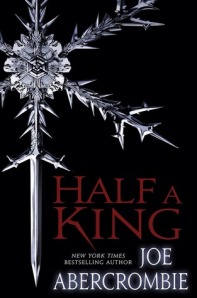I sometimes wonder what life is like at the Abercrombie household. I’m sure they’re a perfectly happy family and that Joe’s a (reasonably) well-adjusted guy, but my imagination gets away with me. I unspool cartoonish scenarios. I picture a great deal of snarling, and spitting, and nose-breaking, and bone-crunching. Dinnertime would be the worst. “Death comes for us all,” Joe snarled as he speared the last chicken leg with his fork. The little Abercrombies puffed their cheeks and eyed Joe sullenly.
There’s a great deal of cheek-puffing in Half a War, the third (and presumably final) entry in Joe Ambercrombie’s Shattered Sea series. And with good reason: As the events begun in Half a King and continued in Half the World come to fruition, Abercrombie’s characters are pushed to their limits. The story opens with Princess Skara fleeing Throvenland, having just evaded the clutches of Bright Yilling (fantasy authors love names like this), murder of her grandfather, who was the king, and his advisor. As Throvenland burns, Kings Uthil of Gettland and Grom-gil-Gorm (seriously, these names) of Vansterland are close to breaking their unsteady alliance–and thus exposing themselves to the advances of the High King. The cunning Father Yarvi, first introduced in Half a King, strives to keep the two kings working together, all in service to his oath to bring down the High King, of course.
The main complaint I can muster about Half a War is that there’s nothing really new here. There is a great deal of violence, although far less than in Abercrombie’s First Law world, presumably since Shattered Sea is aimed at the YA audience. There is conniving and backstabbing, characteristic of Abercrombie’s cynical view of politics and power. And, as there must be, there are a few twists–which I can’t discuss here, of course. If you liked Abercrombie’s other books, you’re likely to enjoy Half a War, too. It’s comforting, in its prickly way. You can count on his characters to be bastards even as they half-heartedly struggle to do the right thing.
The most overtly interesting thing about Half a War is the attention Abercrombie gives the (previously) scarcely-mentioned “elf relics,” artifacts of a lost advanced civilization which sounds remarkably like our own. Indeed, the so-called elf relics play an important role in Half a War, to the point of being a bit of a deus ex machina. But Abercrombie handles it wisely, parsing out only bits of information; he knows that spelling out what happened to the “elves” would ruin the magic. (Although, based on the clues Abercrombie gives, it’s not hard to guess.)
I was impressed, too, by Abercrombie’s (typical) refusal to give his characters tidy resolution. Some characters lose people important to them and are denied the vengeance they seek; others discover that fulfilling a long-planned-for goal can be disappointing. But there are happy endings, too: Some loves are requited, and some characters redeemed–although in a way that’s less satisfactory than they may have hoped. Abercrombie’s characters have to make choices (even if their decisions are often predictable).
Putting predictability aside, the major weakness of Half a War, indeed, of the trilogy, is Abercrombie’s decision to shift his focus to new characters with each book. Half a King was Yarvi’s story, while Half the World was about Thorn and Brand. In Half a War, Abercrombie moves Princess Skara, the warrior Raith, and Yarvi’s apprentice, Koll, to the fore. Previous characters–the ones still alive, anyway–are still present, but in the background. Ultimately, the feeling is disjointed; characters you became attached to in a previous entry are still enticingly there, but far removed. Thorn, for instance, who was perfectly aggravating in Half the World, is barely present in Half a War.
Half a War is weaker than its predecessors, but still quite fun. Although hampered a bit by a predictable plot and its uneven treatment of characters, Half a King makes up for it with Abercrombie’s earthy prose and the compelling Shattered Sea world. I’ve said before that I thought writing for young adults softened Abercrombie’s harder edges, making him more pleasant to read. Although still quite cynical, I far prefer the moral world of the Shattered Sea to that of the grim (and, I suspect, deliberately contrarian) First Law universe. Stalwart Abercrombie fans will most enjoy Half a War; readers new to Abercrombie might want to start with the Shattered Sea.
Similar books:
- Back when I was a Young Turk of book blogging, and actually blogged semi-regularly, I helpfully reviewed Half a King. Now with more adverbs!
- Earlier this year I took a look at Abercrombie’s latest entry in the First Law world, Red Country.
- What’s grimmer than Lord Grimdark? Andy Remic’s The Iron Wolves.



